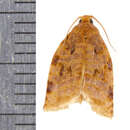Conservation Status
由University of Alberta Museums提供
Not of concern, widespread and abundant.
- 許可
- cc-by-nc
- 版權
- University of Alberta Museums
Cyclicity
由University of Alberta Museums提供
The eggs over winter and hatch in May (Chapman & Lienk 1971). Adults can be found from early July to mid September.
- 許可
- cc-by-nc
- 版權
- University of Alberta Museums
Distribution
由University of Alberta Museums提供
In Alberta this species is common in nearly any open habitat where chokecherry shrubs are present. It is also common throughout southern Canada south to California and New England.
- 許可
- cc-by-nc
- 版權
- University of Alberta Museums
General Description
由University of Alberta Museums提供
"The adults are easily recognized by the orange forewing with many silvery bars. There are distinct brown squared blotches along the costa in the postmedian and median area, along with variable smaller brown markings through the middle of the wing in the antemedian and median areas. The hindwings and most of the body is also orange.
The larva is also distinct by its habits and colouration. Early instars are yellowish green with black legs, head, prothoracic shield, and anal shield. The later instars are bright orange with the same contrasting dark sclerotization and with sparse moderately long pale setae."
- 許可
- cc-by-nc
- 版權
- University of Alberta Museums
Habitat
由University of Alberta Museums提供
Open and shrubby areas especially where there is chokecherry.
- 許可
- cc-by-nc
- 版權
- University of Alberta Museums
Life Cycle
由University of Alberta Museums提供
Eggs are laid in batches on the host plant near the ground. The larvae are found in groups of 30 to 200 individuals and make large messy webs containing large amounts of frass. The webs are made around the terminal shoots of the host, sometimes enveloping entire plants. Pupation occurs inside individual cells inside the shelter. Adults are not very active during the day and can be found resting on chokecherry foliage, but they frequent lights. (Razowski 1977; Chapman & Lienk 1971; MacKay 1962)
- 許可
- cc-by-nc
- 版權
- University of Alberta Museums
Trophic Strategy
由University of Alberta Museums提供
The larvae most commonly feed on the vigorous shoots of small Chokecherry (Prunus virginiana), and occasionally feed upon other members of the Rose family (Rosaceae), willow (Salix spp.), aspen (Populus spp.), and birch (Betula spp.). (Chapman & Lienk 1971; MacKay 1962; Freeman 1958)
- 許可
- cc-by-nc
- 版權
- University of Alberta Museums

